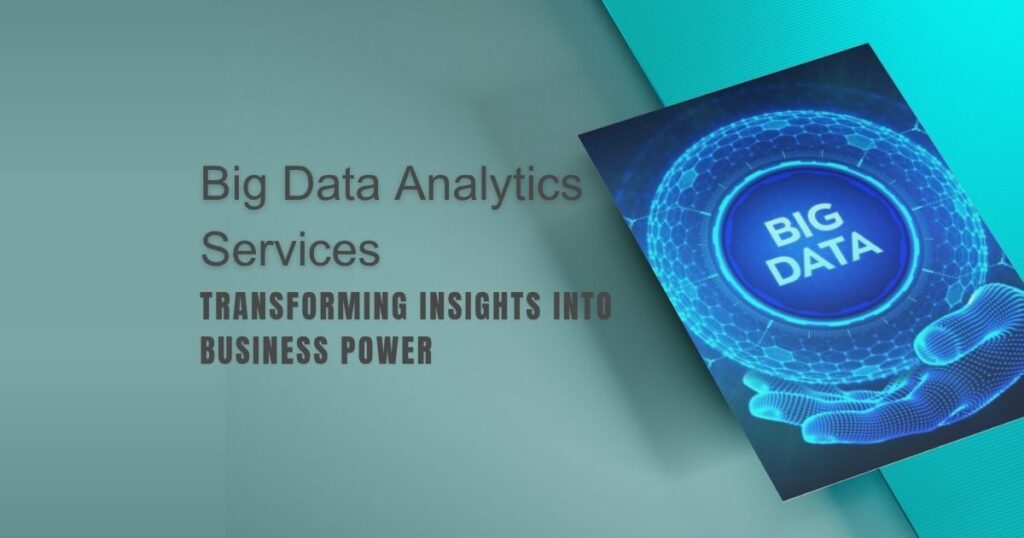In today’s fast-paced digital world, data is being generated at an unprecedented rate. But raw data, on its own, is just noise—until it’s harnessed, analyzed, and transformed into actionable insights. That’s where Big Data Analytics Services come into play. These services are revolutionizing how organizations across industries make informed decisions, optimize operations, and gain a competitive edge.
Let’s dive deep into how big data analytics is not just a tech buzzword but a necessity for modern businesses.
What Are Big Data Analytics Services?
Big Data Analytics Services refer to the tools, technologies, and strategies used to analyze massive volumes of structured, semi-structured, and unstructured data. These services enable organizations to uncover hidden patterns, correlations, trends, and preferences that can inform smarter business decisions.
Why Big Data Matters More Than Ever
We live in a world driven by information. Every click, swipe, purchase, or interaction generates data. But why should businesses care?
-
Volume: Businesses now deal with terabytes or petabytes of data.
-
Velocity: Real-time data processing is crucial for instant decision-making.
-
Variety: Data comes in diverse formats—text, images, videos, and more.
-
Veracity: Ensuring data accuracy and reliability is essential.
-
Value: Extracting meaningful insights from data provides measurable business benefits.
Key Components of Big Data Analytics Services
1. Data Collection & Integration
The first step is collecting data from various sources—CRMs, social media, IoT devices, websites, mobile apps, etc. These are then unified through integration platforms to form a centralized data warehouse or lake.
2. Data Storage Solutions
Efficient storage is critical. Cloud platforms like AWS, Google Cloud, and Azure provide scalable, secure, and cost-effective storage tailored for big data workloads.
3. Data Processing
Technologies like Apache Hadoop and Apache Spark are widely used to process and manage large datasets quickly and efficiently.
4. Data Analysis
Here’s where the magic happens. Statistical models, machine learning algorithms, and visualization tools are employed to identify trends and deliver actionable insights.
5. Data Visualization & Reporting
Using tools like Tableau, Power BI, and D3.js, businesses can present complex data in simple, interactive dashboards that drive better decision-making.
Types of Big Data Analytics
1. Descriptive Analytics
Gives a summary of past data—what happened and why? Think reports, dashboards, and summaries.
2. Diagnostic Analytics
Focuses on root causes. For instance, if your sales dropped last quarter, diagnostic analytics helps pinpoint why.
3. Predictive Analytics
Forecasts future events based on past patterns. Great for demand forecasting, churn prediction, and risk assessment.
4. Prescriptive Analytics
Recommends actions based on predictive insights. Should you increase ad spend? Where should you allocate resources? Prescriptive analytics helps with that.
Industries Benefiting from Big Data Analytics
Healthcare
Predicting disease outbreaks, personalizing treatments, optimizing hospital operations.
Retail
Tracking customer preferences, managing inventory, optimizing pricing strategies.
Finance
Fraud detection, risk management, real-time market insights.
Manufacturing
Supply chain optimization, predictive maintenance, quality control.
Marketing
Targeted campaigns, sentiment analysis, performance tracking.
Benefits of Big Data Analytics Services
-
Improved Decision Making: Move from gut-feeling to data-backed strategies.
-
Enhanced Customer Experience: Understand customer needs and behaviors deeply.
-
Operational Efficiency: Identify bottlenecks and areas of improvement.
-
Revenue Growth: Spot opportunities, upsell, and cross-sell.
-
Risk Management: Detect anomalies, prevent fraud, and ensure compliance.
Challenges in Implementing Big Data Analytics
1. Data Privacy and Security
Handling personal data requires robust security protocols and compliance with regulations like GDPR.
2. Data Quality
Garbage in, garbage out. Poor data quality leads to misleading insights.
3. Skills Gap
Many companies struggle to find professionals skilled in big data technologies.
4. Infrastructure Costs
Building a scalable infrastructure can be expensive for small and mid-sized businesses.
Choosing the Right Big Data Analytics Service Provider
When selecting a partner, consider:
-
Experience: Proven track record across industries.
-
Technology Stack: Familiarity with modern tools and frameworks.
-
Customization: Ability to tailor services to your business goals.
-
Scalability: Infrastructure that grows with your data needs.
-
Support: Strong post-deployment support and training.
Top Tools Used in Big Data Analytics
-
Apache Hadoop: Open-source framework for distributed storage and processing.
-
Apache Spark: Lightning-fast big data processing engine.
-
Tableau & Power BI: Leading data visualization platforms.
-
NoSQL Databases: MongoDB, Cassandra for scalable data storage.
-
Python & R: Programming languages for statistical analysis.
The Role of AI and Machine Learning in Big Data Analytics
AI is taking big data analytics services a to the next level. Machine learning models can:
-
Predict trends with high accuracy.
-
Personalize experiences at scale.
-
Automate decision-making processes.
-
Continuously learn from new data.
Think of AI as the brain, and big data as the fuel.
Cloud vs. On-Premises Big Data Analytics
Cloud-Based Analytics
Pros: Scalable, flexible, cost-effective, easier integration.
Cons: Dependency on internet connectivity, data sovereignty concerns.
On-Premises Analytics
Pros: Full control over data, better for regulatory compliance.
Cons: High upfront costs, limited scalability.
How to Get Started with Big Data Analytics Services
-
Identify Objectives: Know what you want to achieve—cost reduction, customer insights, etc.
-
Assess Data Sources: Understand where your data is coming from.
-
Select a Service Provider: Choose based on needs, budget, and goals.
-
Start Small: Begin with a pilot project.
-
Scale: Expand after validating success.
Future Trends in Big Data Analytics
-
Edge Computing: Bringing data processing closer to the source.
-
Real-Time Analytics: Instant insights for faster decisions.
-
Data-as-a-Service (DaaS): On-demand access to external datasets.
-
Explainable AI (XAI): Making machine learning outcomes transparent.
-
Sustainability Analytics: Using data to drive environmental impact reductions.
Conclusion
Big Data Analytics Services are no longer optional—they’re critical for staying competitive in a digital-first world. Whether you’re a startup or an enterprise, leveraging big data allows you to turn chaos into clarity, guesswork into strategy, and data into your most valuable asset. It’s time to dig deep, analyze smart, and make bold, data-driven moves.
FAQs
1. What industries use Big Data Analytics Services the most?
Finance, healthcare, retail, and manufacturing are among the top industries leveraging big data for growth and innovation.
2. Can small businesses afford big data analytics?
Absolutely. Cloud-based analytics platforms have made it affordable and scalable for businesses of all sizes.
3. How secure is big data analytics?
With proper encryption, access controls, and compliance practices, big data analytics can be highly secure.
4. How long does it take to see results from big data analytics?
Some results like process optimizations can be immediate, while strategic insights may take a few months of data accumulation.
5. Do I need in-house experts to start with big data?
Not necessarily. Many service providers offer end-to-end solutions, including setup, management, and reporting.
- Big Data Analytics Services: Transforming Insights into Business Power
- Discover how Big Data Analytics Services are empowering modern businesses to make smarter decisions, improve efficiency, and drive innovation across industries with real-time insights and advanced data processing technologies.
- #BigDataAnalytics, #DataDrivenDecisions, #BusinessIntelligence, #AIandAnalytics, #PredictiveAnalytics, #DataScience, #TechInnovation, #CloudAnalytics, #DigitalTransformation, #MachineLearning
Related posts:
 High-Quality Biomedical Waste Incinerators & Laboratory Glassware Made in India
High-Quality Biomedical Waste Incinerators & Laboratory Glassware Made in India
 Understanding the Role of IoT in Modern Manufacturing: A Comprehensive Guide to Smart Factories and Industrial Transformation
Understanding the Role of IoT in Modern Manufacturing: A Comprehensive Guide to Smart Factories and Industrial Transformation
 Smarter Business Networks Start with a Cisco Solution Provider Partner
Smarter Business Networks Start with a Cisco Solution Provider Partner
 Best Account Management Software for All Businesses – EmizenTech
Best Account Management Software for All Businesses – EmizenTech
 Top 15 Global Website Design Companies You Can Hire in the 2025
Top 15 Global Website Design Companies You Can Hire in the 2025
 Empowering Qatari Retail Businesses with Microsoft Dynamics 365 Commerce
Empowering Qatari Retail Businesses with Microsoft Dynamics 365 Commerce
 Top On-Demand Dating App Trends to Watch and Leverage in 2025
Top On-Demand Dating App Trends to Watch and Leverage in 2025
 Safety Procedures in Heavy Equipment Moving: Best Practices for Workplace Security
Safety Procedures in Heavy Equipment Moving: Best Practices for Workplace Security







